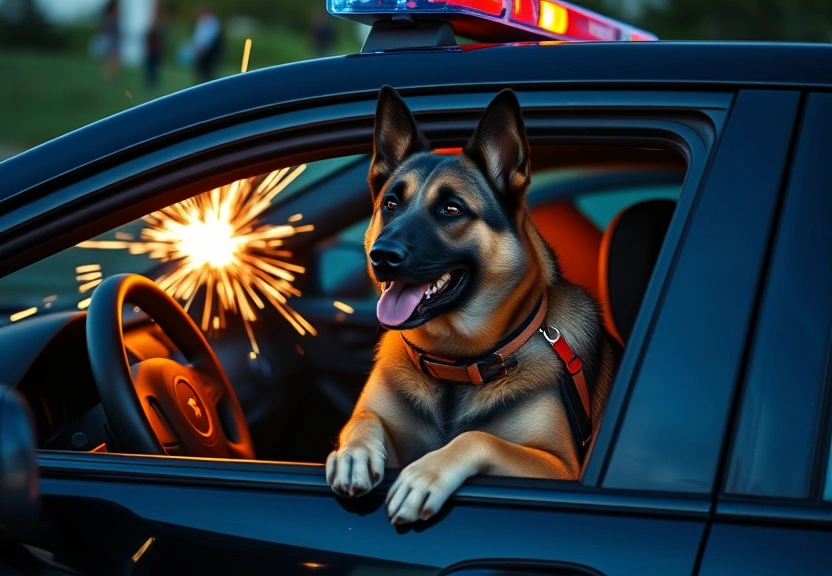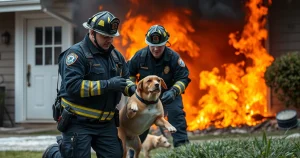Contents
ToggleTragic Death of Police Dog in Hot Patrol Car Sparks Investigation in Hawaii
The recent death of K9 Archer, a dedicated police dog with the West Hawaii Police Department, has ignited outrage and sorrow within the community. On September 4, Archer, a 6½-year-old Belgian Malinois and German shepherd mix, succumbed to heat exhaustion after being left in a patrol vehicle for what officials have described as an “unacceptable” amount of time. Not only did this incident result in the tragic loss of a devoted service animal, but it has also prompted an investigation into the circumstances surrounding this preventable death.

K9 Archer was more than just a police dog; he was a beloved member of the force, serving alongside his handler in the vice section’s narcotics unit since 2021. His tragic passing has raised critical questions about the protocols in place for the care of police animals and the measures that should be taken to prevent such incidents from occurring in the future. This article aims to explore the details surrounding the incident, the implications for law enforcement practices in Hawaii, and the broader conversation about animal welfare in police work.
The Incident: A Preventable Tragedy
According to reports from the West Hawaii Police Department, K9 Archer was left unattended in a patrol car during a routine shift on September 4. The interior of the vehicle reached dangerously high temperatures, leading to Archer’s untimely death. The police department has since expressed deep regret over the incident, calling it a failure that must be addressed to prevent any future occurrences.
Understanding the Risks of Leaving Animals in Vehicles
Many people may not realize how quickly temperatures can rise inside a parked vehicle, even on seemingly mild days. Studies have shown that temperatures inside a car can increase by 20 degrees Fahrenheit in just 10 minutes. This rapid rise in temperature can create a deadly environment for animals left inside, with heat stroke being a common and tragic outcome.
The risks are especially pronounced for working dogs like Archer, who are not only more susceptible to heat stress but also have unique needs due to their training and working conditions. Their physical exertion during patrols can exacerbate the effects of high temperatures, making it crucial for handlers to remain vigilant.
The Role of K9 Units in Law Enforcement
K9 units play a vital role in modern law enforcement, providing invaluable assistance in areas such as drug detection, search and rescue, and crowd control. Dogs like Archer are specially trained to work alongside their human counterparts, often forming strong bonds that extend beyond the workplace.
Training and Responsibilities of K9 Handlers
K9 handlers undergo extensive training not only in their specific law enforcement duties but also in the care and management of their canine partners. This training emphasizes the importance of ensuring the well-being of the dog, including proper hydration, exercise, and temperature management. The tragic loss of Archer has sparked a discussion about the adequacy of this training and the responsibilities of handlers when it comes to the safety of their K9 companions.
Community Response and Investigation
The community’s reaction to K9 Archer’s death has been one of profound sadness and anger. Many residents have taken to social media to express their condolences and demand accountability from the police department. The Hawaii Police Department has announced an internal investigation to examine the circumstances surrounding the incident and to determine if any policies were violated.
Importance of Accountability in Law Enforcement
Accountability in law enforcement is a crucial aspect of maintaining public trust. Incidents like the death of K9 Archer can undermine that trust, highlighting the need for transparency and a commitment to learning from mistakes. The investigation into Archer’s death will likely lead to a reassessment of existing protocols regarding the care of police animals, as well as potential disciplinary actions for those involved.
Preventive Measures and Future Protocols
In light of Archer’s tragic death, there is an urgent need for law enforcement agencies to review and enhance their protocols surrounding the care of K9 units. Implementing preventive measures can help ensure that such incidents do not happen again.
- Education and Training: Providing K9 handlers with ongoing education about the risks associated with heat exposure and the importance of monitoring their dog’s well-being.
- Regular Policy Reviews: Establishing a routine review of policies related to the care of K9s, including guidelines for leaving dogs in vehicles.
- Temperature Monitoring Devices: Utilizing technology to monitor the temperature inside patrol vehicles, alerting handlers if conditions become unsafe.
- Clear Accountability Measures: Instituting clear accountability structures for K9 handlers to ensure compliance with safety protocols.
- Community Engagement: Involving the community in discussions about animal welfare and law enforcement practices to foster transparency and trust.
FAQs about K9 Units and Heat Safety
1. What are the signs of heat stroke in dogs?
Common signs of heat stroke in dogs include excessive panting, drooling, lethargy, vomiting, and a rapid heartbeat. If you notice these symptoms, it’s crucial to cool the dog down immediately and seek veterinary attention.
2. How can law enforcement prevent similar incidents in the future?
Law enforcement agencies can prevent similar incidents by implementing stringent protocols for K9 care, including temperature monitoring, regular training, and accountability measures for handlers.
3. What is the typical working lifespan of a police dog?
The typical working lifespan of a police dog varies but generally ranges from 7 to 10 years, depending on the dog’s breed, health, and workload.
4. How can the community support K9 units?
The community can support K9 units by advocating for proper funding, participating in educational programs about K9 safety, and engaging with law enforcement to ensure transparency and accountability.
5. What should a handler do if they cannot safely monitor their K9?
If a handler cannot safely monitor their K9, they should seek alternative arrangements, such as allowing the dog to remain in a cooler environment or assigning another officer to assist with the dog’s care.
Conclusion
The tragic death of K9 Archer serves as a somber reminder of the responsibilities that come with working alongside police animals. As the investigation unfolds, it is hoped that valuable lessons will emerge to prevent such a heartbreaking incident from happening again. Improving protocols and ensuring the well-being of K9 units is not only a matter of duty but also a reflection of our commitment to the animals that serve alongside us. The loss of Archer will not be in vain if it leads to meaningful changes in how law enforcement agencies prioritize the safety and welfare of their K9 companions.
📰 Original Source
Este artigo foi baseado em informações de: https://iheartdogs.com/hawaii-police-dog-dies-hot-car/?utm_source=rss&utm_medium=rss&utm_campaign=hawaii-police-dog-dies-hot-car





